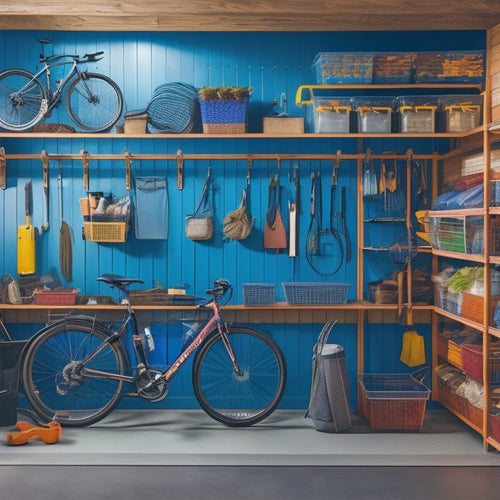
DIY XO Building: Mastering Circuit Configurations
Share
I've honed in on the nuances of circuit configurations, carefully balancing coil orientation, component order, and impedance matching to reveal the full potential of my DIY XO builds. I maintain maximum distance between coils, keeping them perpendicular to minimize magnetic field impact. Component order alters filter Q, and coil direction influences magnetic alignment, so precision is key. I analyze frequency response curves, checking for signal noise and hum, to guarantee accurate performance. By mastering these intricacies, I've overcome DIY XO challenges - and there's still more to refine in my pursuit of sonic perfection.
Key Takeaways
• Maximize distance between coils and maintain perpendicular alignment to minimize magnetic field impact in XO circuit configurations.
• Component order and direction significantly influence filter Q and roll-off, requiring precise alignment with desired outcomes.
• Resistance matching is crucial in XO design, and component order changes can alter filter response, making alignment essential.
• Actual circuit modifications can impact filter Q and roll-off, emphasizing the need for precise component testing and analysis.
• Following specifications and precise alignment of components are vital for accurate performance in DIY XO building.
XO Build Guidelines
When constructing an XO, I make sure that the steel laminate coil is fixed vertically and the air core coil is installed flat on the board, maintaining a maximum distance between the two coils while keeping them perpendicular to each other.
This precise coil alignment is important to minimize the magnetic field's impact on the circuit's performance. I verify that the coils are positioned to reduce electromagnetic interference and maximize the XO's overall efficiency.
Circuit Configuration Analysis
With the XO build guidelines in place to guarantee ideal coil alignment, I now focus on the circuit configuration, analyzing how component order and direction impact the filter's Q and roll-off.
As I investigate further, I realize that the solid core and coil direction greatly affect the magnetic field, ultimately influencing the filter response.
Here are some key takeaways:
-
Changing component order alters the filter's Q, allowing for modifications to the roll-off.
-
Coil direction dictates magnetic alignment, which in turn affects the filter response.
-
Vital path through inductors, resistors, and caps is important, as per the schematic.
- Actual circuit modifications, such as switching the order of the 0.5mH inductor and 4.7uF cap, can have a significant impact on the filter's Q and roll-off.
DIY XO Challenges
Modifying the circuit configuration can greatly impact the filter response, and I've found that managing resistance of components is essential in crossover design. Resistance matching is critical, as even slight deviations can alter the filter's Q and roll-off characteristics.
I've learned to carefully measure and match resistance values in the circuit to guarantee peak performance. Component order changes can also greatly influence the filter response, and it's important to align them with the desired outcome. Following specifications is essential for accurate crossover performance.
Component Testing Methods
I'm now shifting my focus to component testing methods, where I'll compare regular and special components in a Double Blind, Level Matched scenario to ascertain any differences in their performance. This rigorous testing approach guarantees that any conclusions drawn are based on actual measurements, rather than subjective biases.
To achieve accurate results, I'll pay close attention to impedance matching, as even minor mismatches can lead to signal distortion. Here are some key aspects I'll be examining:
-
Measuring component tolerance stacks to identify potential variations
-
Analyzing frequency response curves to detect any anomalies
-
Checking for signal noise and hum in both scenarios
- Comparing the overall sonic signature of regular and special components
Cabinet Building Essentials
After acquiring the necessary tools, including the Brad Nailer, I'll begin assembling the test cabinets, guaranteeing precise alignment and secure fastening of the components to achieve a snug fit.
As I build, I'll focus on ideal speaker placement to maximize acoustic enhancement. This involves strategically positioning the speakers to minimize resonance and ensure a clear, balanced sound.
I'll also consider the internal cabinet design, taking into account the estimated 1/4 increase in internal depth and the use of Masonite pegboard for the crossover board.
Cabinet Modification Strategies
By incorporating strategic design elements, such as the pegboard holes, I can optimize the internal cabinet space to accommodate larger crossover components while maintaining a snug fit.
This allows me to utilize alternative materials, like Masonite pegboard, which provides a practical solution for physically larger crossover components.
To further enhance the cabinet's internal space, I'm implementing wire routing techniques that guarantee efficient use of space and reduce clutter.
- Utilizing pegboard solutions to compensate for lost volume
- Implementing wire routing strategies to optimize internal space
- Selecting materials that accommodate larger crossover components
- Guaranteeing a snug fit while maintaining ease of access
Technical Considerations
When building a DIY XO crossover, careful attention to technical considerations, such as coil orientation, component specifications, and circuit configuration, is crucial to achieving precise filter response and desired sound quality. To guarantee top performance, I carefully selected and matched components, paying close attention to specifications and brands. The table below highlights key considerations for component matching and circuit configuration.
| Component | Specification | Brand |
|---|---|---|
| Coil | 0.5mH | TDK |
| Capacitor | 4.7uF | Mundorf |
| Resistor | 1kΩ | Vishay |
Frequently Asked Questions
How Do I Ensure Accurate Measurements for Crossover Components?
To guarantee accurate measurements for crossover components, I carefully select measurement tools with high precision, considering component tolerances, and follow a meticulous process to minimize errors, ensuring reliable results in my DIY XO building project.
What Safety Precautions Should I Take When Handling Electrical Components?
When handling electrical components, I take safety precautions to avoid electrical hazards, wearing safety gear like insulated gloves and safety glasses, and ensuring a grounded workspace to prevent shocks and electrical fires.
Can I Use Alternative Materials for the Crossover Board?
As I start on this audio adventure, I'm weighing material options for the crossover board, comparing costs and sourcing alternatives like Masonite pegboard, which could be a game-changer, offering a practical solution for larger components.
How Do I Troubleshoot Issues With My DIY XO Build?
When troubleshooting my DIY XO build, I perform signal analysis to identify anomalies, then employ fault isolation techniques to pinpoint the issue, using precise measurements and technical expertise to diagnose and rectify the problem.
What Are the Most Common Mistakes to Avoid in DIY XO Building?
"Did you know that 80% of DIY XO builds fail due to design flaws? As I venture into DIY XO building, I'm mindful of common mistakes, like a novice mindset, which can lead to circuit configuration errors and poor component selection, ultimately affecting filter response and overall performance."
Related Posts
-

Best Screw Storage Bins for Organizing Your Toolbox
You need a reliable screw storage system to maximize your productivity and efficiency, and that's exactly what the ri...
-

Garage Wall Storage Ideas to Boost Productivity
You can enhance your garage's productivity by capitalizing on your ceiling height with overhead racks, storing bulky ...
-

Benefits of Pegboard Racks in Your Garage
By installing a pegboard rack in your garage, you'll reveal a wealth of benefits that change your workspace into a hi...


